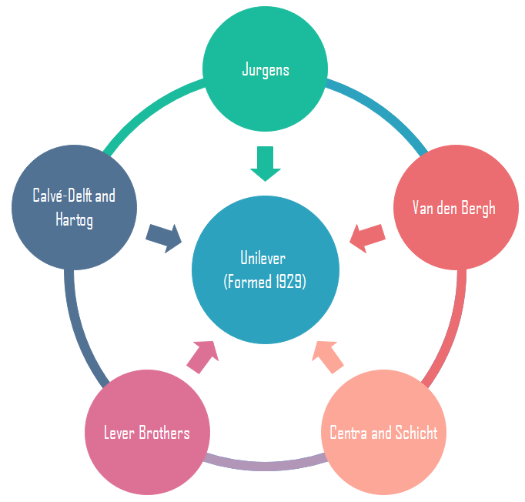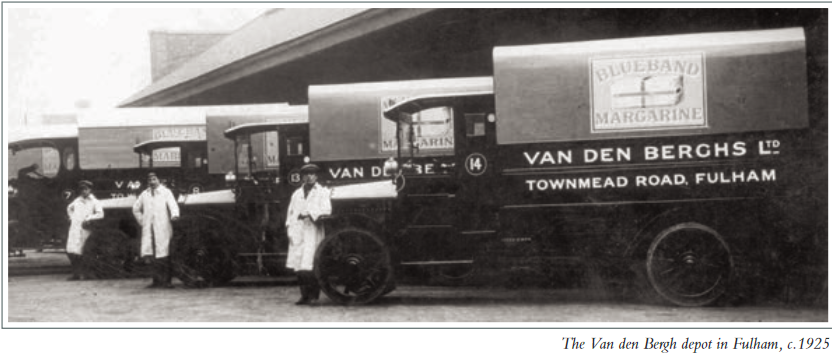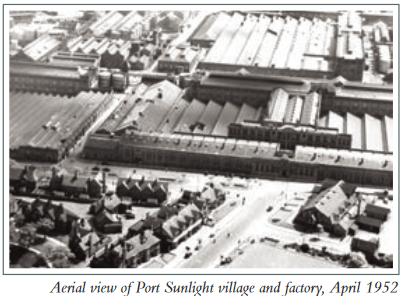Unilever PLC
Company Overview
Unilever PLC is a global brand in the fast-moving consumer goods (FMCG) industry in the world. The company was founded over 100 years ago. It is one of the largest consumer goods companies globally. It is known for its great brands, global footprint and for doing business in a right way.1
The products of the company are available in around 190 countries in the world. About 3.4 billion use the products of Unilever every day; turnover of the company was €52 billion in 2021. It has 400 powerful brands worldwide. The company has 148,000 employees worldwide.
History of Unilever2
A dedicated historic home of Unilever is located at Port Sunlight, UK where a team is responsible for the management of Unilever Art, Archives and Records. According to the historic centre, the documents of Unilever dates as back as 1292.3 However, ‘material’ history of the company starts from 1990s.
To start with, it is to point towards the agreement that was signed in September, 1929 on the merger of Margarine Union and Lever Brothers Limited. Margarine Union was formed in 1927 by the Van den Bergh and Jurgens companies. The constituents of Margarine Union were based in Netherlands and they were conglomerates of a number of other Dutch and central European companies. The history of Van den Berghs and Jurgens companies is explained hereafter.
History of Van den Berghs
Simon Van den Bergh was the founder of this company. He entered his father’s barter trade at an early age. Later on, he started a thriving butter trade in the village Oss in Brabant, which he later decided to expand by exporting butter to England. In 1869, a butter substitute, margarine, made from animal fat, was invented by Mège Mouriès. Soon, Van den Bergh adopted the formula and crossed all their rivals in the same business to top the market. The development of hydrogenation, a technique for hardening vegetable oils made it possible to use a wide range of raw materials, not just animal fat. In 1891, Van den Bergh left Oss for new headquarters in Rotterdam, Netherlands.
Owing to the success of the company in late nineteenth century, and lack of financial backups in the family, Van den Bergh went public in London on 9 March, 1995, as it was easier to raise capital in London, and sold the previous partnership to the newly formed public limited company named ‘Van den Bergh’s Margarine Limited. Later in 29 May, 1897, the word Margarine was dropped to name the company Van den Berghs Limited. The English business then acted as a holding company for the family’s business interest.
The precedent for the creation of Margarine Union and then Unilever lies in a series of new company creation by Van den Bergh and some agreements. In 1919, Van den Berghs founded Van den Bergh's Fabrieken NV in Rotterdam to which the Dutch side of the family transferred their shares. The entire business then controlled Van den Bergh Group. A third company was introduced namely NV Hollandsche Vereeniging tot Exploitatie van Margarinefabrieken, whose shares were entirely held by the second company. An agreement among these three companies were signed that they will maintain a ratio in disbursing dividend, or any payment or liquidation money. The company then created two parent companies, one in England and another in Netherlands, in order to avoid problems like double taxation.
History of Jurgens Company
The history of Jurgens Company starts interestingly with the farmers paying them with butter in exchange of their carpentry works along the Dutch-German border. The Jurgens family repaired agricultural implements and farm utensils. The farmers lacked ready money hence paid them with butters which the Jurgens sold in the nearby towns. Seeing the profit in this, brother Willem, Jan and Leonard Jurgens moved to the Dutch town of Oss in 1801 to focus their attention on the butter trade.
The family business grew up and started producing margarine in 1870s. By the end of 1888, Jurgens as well as Van den Bergh was making margarine in Germany. Jurgens launched a branded margarine – Solo in 1899; in 1904, they succeeded in buying a competitor, A L Mohr of Hamburg. In the buying process, the Jurgens dodged its competitor, Van den Bergh. A general company, NV Anton Jurgens Vereenigde Fabrieken, was set up in 1906 to hold all the Jurgens’ interests in The Netherlands.
History of Lever Brothers
Lever Brothers was a British soap manufacturing company that started its journey in 1885 to become of the leading companies in the world. The company was founded by William Hesketh Lever and James Darcy Lever in 1885, as a starter it was a soap-making shop in Warrington. The brothers collaborated with Cumbrian chemist William Hough Watson, who invented a new formula for making soaps using glycerin and vegetable oils such as palm oil instead of tallow. The first soap was named ‘Honey Soap’ and later on renamed to ‘Sunlight Soap’. The demand was so high that production reached 450 tons by 1888. The company entered the US market in 1895 and in 3 years it bought a soap manufacturer in Cambridge, Massachusetts, the Curtis Davis Company. In 1925, Lever Brothers acquired Mac Fisheries, and by 1929, the company employed more than 1,000 workers in Cambridge and became third-largest soap manufacturer in the US.
The company introduced Lifebuoy soap in 1894 and ‘Lux’ in 1899. In American market, the brand Sunlight was a failure. But Lifebuoy, Lux and Rinso brought success to the company. Francis A. Countway helmed the American operation of the company. He understood very well that selling to the Americans is quite different from selling to the Europeans. He devised his new heavy promotional activities and served the company for 25 years. By 1919, the company was selling a million and a half cases of ‘Lux’ alone. Meanwhile, the parent company in England made a deal to finally become Unilever in association with Margarine Unie. The two companies would have a different set of shareholders but a single board of directors.
The pooling agreements
The three companies – Jurgens, Van den Bergh, and Lever Brothers, has been growing at their own paces at different places and in different markets. Meanwhile, in the early 20th century, Jurgens and Van den Bergh were rivals but they came to secretly pool their interests through an agreement reached on February 13, 1908. The reason behind this agreement was the stiff competition in England from Otto Monsted, as well as plentiful supply of margarine in The Netherlands. In summer of 1907, Jan Jurgens approached Arnold Van den Bergh with the proposal to cooperate closely. The agreement was roughly to split the profit into a ratio of 60:40 between Van den Bergh and Jurgens. However, although the talk was to sustain the agreement until 1926, it merely survived until 1913 when the division of profits were made equal.
During the WWI, the oils and fats industry were under direct control of the government since the later was using it in producing supplies of soap and margarine as well as glycerine, a by-product. The glycerine was used as explosives. In the post-war time, Jurgens started their own plant in England in 1917. They also started buying their own factories to extend their production. They successfully bought Olympia Oil mill in Yorkshire over the bid put forward by lever brothers. On the other side, Van den Bergh also extended their Fulham factory. But the boom did not last since Jurgens and Van den Bergh suffered for the slump in margarine market as well as high competition from not only Otto Monsted but from Lever Brothers.
In the meantime, the pooling agreement was renewed in October 1920 and was supposed to be maintained until 1940. An Entete Agreement was signed that included two more companies – Centra and Schicht by the end of 1920 to counter the ever-increasing competition.
The merger: Formation of Margarine Union
By 1927, the margarine industry was stagnant and showed no signs of recovery. Lengthy legal processes rendered the pooling agreement between Jurgens and Van den Bergh dysfunctional. Finally, Jurgens suggested the option that had been on the cards for so long – a merger. The merger was signed on 2 August, 1927. The merged company assumed a new name – Margarine Union.
Under a complicated system ensued by the tax system of the countries, the Union had to create two holding companies – one in The Great Britain, and other in the Netherlands. The system was that the British Government would not tax the profits given as dividend to the owners; but the tax system of The Netherlands would do so. Therefore, whilst parent company was in The Netherlands, they would pay tax in The Britain on its profits, and again when the profits were distributed as dividends, the Netherland’s government would tax them. Thus, the problem of double taxation existed. But when the ownership was split, the profits from British operation would not be double taxed anymore. Two holding companies were created under same board of directors – Margarine Union Limited and NV Margarine Unie in The Great Britain and The Netherlands, respectively.
Birth of Unilever
Originally, the negotiations between Margarine Union and Lever Brothers started in order to reach an agreement on the use of raw materials. The initial discussions were about the business lines of the companies. In 1928, it was suggested that Lever Brothers should transfer their margarine interests to the Margarine Union and the Margarine Union transfer its soap companies to Lever Brothers. This expanded into discussions about regulating supplies of raw materials and co-operation in oil milling and refining, the production of edible fats other than margarine, and the disposal of by-products.
The talk about amalgamation of the two companies’ interests were placed in several forms but none worked out as the financial structure of the companies were quite different – Lever Brothers consisted of preference shares while Margarine Union was of ordinary shares. However, John McDowell of Lever Brothers and Paul Rijkens of the Margarine Union eventually came up with a solution. The solution was such – the ordinary shares of Lever Brothers would be amalgamated with that of Margarine Union companies, so that control of the both organisations would be in the hands of the holders of ordinary shares of Lever Brothers and controlling shares of the Margarine Union companies.
The agreement was reached on 2 September, 1929 and came to be known as the Equalisation Agreement. It is still in force today. The holding companies were Unilever Limited and Unilever NV.
Thus, Unilever came into being on 1 January, 1930 as the agreement was enforced on this day.
From time to time, entities in the following figure have comprised what today is known as Unilever4 -

Image gallery



Timeline of Unilever
| Year | Particulars |
| 1801 | Brothers Willem, Jan & Leonard Jurgens, move to Oss in The Netherlands to develop their butter trade |
| 1819 | Simon Van den Bergh, founder of the family’s margarine business, born |
| 1820 | Georg Schicht, founder of the family business, born |
| 1848 | Schicht acquire permission to build a soap factory in Ringelshain, Bohemia |
| 1851 | Birth of William Hesketh Leve |
| 1854 | Gebroeders Jurgens company formed in The Netherlands |
| 1869 | Invention of margarine by Mège Mouriès in France |
| 1870 | Jacob and Henry Van den Bergh move to England |
| 1871 | Jurgens family acquire the patent for making margarine |
| 1882 | Schicht build a factory in Aussig, Central Europe |
| 1884 | William Lever registers Sunlight trademark in the UK |
| 1885 | Lever Brothers started by William Lever and his brother |
| 1888 | Lever Brothers open a sales office in Sydney, Australia (Its first overseas.) |
| 1890 | Lever Brothers becomes a private limited company in the UK |
| 1891 | The Van den Bergh family leave Oss and move to Rotterdam |
| 1895 | Van den Bergh establishes a public limited company, Van den Berghs Margarine Ltd in the UK |
| 1897 | Merger of Calvé and Delft (France/Netherlands) |
| 1898 | Vitello margarine launched by Van den Bergh in Germany |
| 1899 | Jurgens launch Solo margarine in Germany |
| 1904 | Sanella margarine launched by Van den Bergh in Germany |
| 1906 | Jurgens set up NV Anton Jurgens' Vereenigde Fabrieken, comprising all the Jurgens interests in the Netherlands |
| 1908 | 1st Pooling Agreement in The Netherlands |
| 1912 | Centra formed in Central Europe |
| 1913 | 2nd Pooling Agreement in The Netherlands |
| 1916 | Blue Band launched in the UK by Van den Bergh |
| 1917 | Jurgens margarine factory opens at Purfleet in the UK |
| 1919 | Van den Bergh forms Van den Bergh's Fabrieken NV in Rotterdam, to which all the company’s continental interests are transferred |
| 1920 | Stork margarine is launched in the UK by Jurgen; 3rd Pooling Agreement in The Netherlands; The Little Entente signed between Jurgens, Van den Bergh, Centra and Schicht; The Great Entente signed between Jurgens, Van den Bergh, Centra and Schicht. |
| 1923 | Blue Band launched in the Netherlands |
| 1924 | Rama margarine launched by Jurgens in Germany |
| 1925 | Lux soap launched by Lever Brothers in the USA; Death of William Lever, 1st Viscount Leverhulme |
| 1927 | Viking, the first vitaminised margarine, launched by Lever Brothers in the UK; Formation of the Margarine Union |
| 1928 | Calvé-Delft joins Margarine Union in September; Schicht and Centra join Margarine Union at the end of the year |
| 1929 | Hartog joins Margarine Union in January; Equalisation Agreement signed between Lever Brothers Limited and NV Margarine Union on 2 September |
| 1930 | Unilever came into being on 1 January |
- ^ https://www.unilever.com/our-company/at-a-glance/
- ^ https://www.unilever.com/files/origin/3d0982a9cc0a89b9b4834edc8023cb1e54477f4e.pdf/formation-of-unilever-brochure.pdf
- ^ https://www.unilever.com/our-company/our-history-and-archives/
- ^ For details history consult this pdf:
https://www.unilever.com/files/origin/3d0982a9cc0a89b9b4834edc8023cb1e54477f4e.pdf/formation-of-unilever-brochure.pdf




